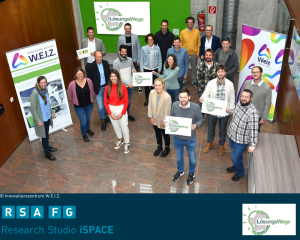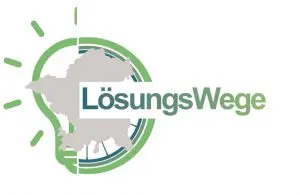In the LösungsWege project, the Salzburg studio is working together with a large consortium on inter-municipal, regional mobility solutions.
The transport sector was responsible for almost 30 per cent of total emissions in Austria in 2022. In Styria, it is even responsible for almost half of the greenhouse gas emissions and personal mobility alone for two thirds of this. This is a poor balance – in Austria’s major cities, eco-mobility has steadily pushed back motorised private transport (MIT) in recent years.
In rural areas in particular, an already sparsely populated urban sprawl is faced with a lack of access to public transport systems. As a result, over 68 per cent of journeys in Styria are made by private motorised transport, with a peak value of 77 per cent in south-eastern Styria.
The new LösungsWege project, chaired by the Innovation Centre W.E.I.Z. in Styria, aims to counteract this with inter-municipal cooperation in Eastern Styria. This is because Austria often lacks the resources, capacities and data to enable such cooperation models for mobility provision.
Eastern Styria (201,993 inhabitants), its 15 climate and energy model regions and their 72 municipalities across districts serve as the focus area in LösungsWege. There is a lack of mobility chains in the region, and there is also too much dependence on motorised private transport due to poor accessibility of the first and last mile. More and more municipalities and regions are recognising their own need for action, but flexible forms of mobility or on-demand offers such as micro-public transport, e-car sharing, bike sharing, e-charging stations) are currently mostly geographically limited individual measures.
47 per cent eco-mobility instead of 68 per cent MIV
LösungsWege supports the development of expertise between the stakeholders, from municipalities to transport associations, in order to systematically integrate new on-demand services into an overall system in the long term.
At the heart of LösungsWege are new intermodal and inter-municipal forms of cooperation and organisation that support the coordination and integration of existing and new public and private on-demand services. LösungsWege has the potential to help increase the share of eco-mobility in passenger mobility to 47 per cent and achieve climate neutrality by 2040. A particular focus in the overall system is on inter-municipal and regional mobility solutions using the example of Eastern Styria – representative and transferable for other regions in Austria.
Comprehensive data on personal mobility is currently not available at municipal level. There is a great need for nationwide data innovations and digital innovations for evidence-based foundations for the development of new on-demand services.
Solution approaches and research design
The iSPACE studio is leading the work package ‘Understanding mobility demand – bottom-up GHG inventories’. The focus is on a standardised, Austria-wide applicable preparation, analysis and presentation of mobility demand for locations in order to develop evidence-based planning principles and thus strengthen transport and energy planning drivers, minimise obstacles and develop necessary concepts.
Milestones will be the development and realisation of a transferable spatial model for estimating location-related transport costs. A GIS model for the area-wide calculation of location quality and routes for everyday mobility (transport expenditure in passenger kilometres) at residential locations was created as a prototype for Salzburg and will be further developed in the project.
LösungsWege will identify the relevant stakeholders and players in the region and bring them together for an in-depth needs assessment. To this end, the on-demand offers and their stakeholders in Eastern Styria will be collected, evaluated and the information gap

Experience from other projects
LösungsWege benefits from other projects, also involving iSPACE. In the preliminary project GEL S/E/P II, infrastructural location qualities within walking distance of the place of residence (city of short distances) were calculated for the province of Salzburg and compared with the mobility offer. This approach is extended to different modes of transport for location-based analyses of everyday mobility routes. Approaches from the ULTIMOB and PRIMA projects, where prototype potential models for integrated services were developed, will be expanded and integrated into the solution-path evaluation model.
LösungsWege can build on and further develop both technological and content-related components from other reference projects and models from Research Studios Austria, such as public transport quality classes or the Austrian accessibility model. The prototype implementation and planning valorisation in Eastern Styria can demonstrate how these results can promote inter-municipal cooperation models and contribute to a sustainable improvement in regional mobility provision.
Studio iSPACE is also involved in the work package ‘Innovative foundations for integrated spatial transport planning and the development and implementation of new integrated and needs-based mobility services’.
A kick-off meeting has already taken place at the W.E.I.Z. innovation centre, where the consortium discussed the objectives and plans once again.
Consortium:

- Lead: W.E.I.Z. Forschungs & Entwicklungs GmbH
- AEE – Institut für Nachhaltige Technologien
- Energie Agentur Steiermark gemeinnützige GmbH
- FAMILY OF POWER SCE mit beschränkter Haftung
- Hauser Verkehrsplanung KG
- MGAtech GmbH
- Paradieschen GmbH
- Regionalentwicklung Oststeiermark GmbH
- Research Studios Austria Forschungsgesellschaft mbH
- Stadtgemeinde Weiz
- StadtLABOR – Innovationen für urbane Lebensqualität GmbH
- Universität Graz, Institut für Bewegungswissenschaften, Sport und Gesundheit

